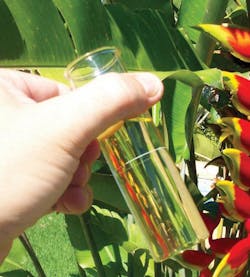I know, you’re probably thinking “Great, another company exploiting the world’s precious rain forests.” But as Dave points out, just the opposite is true. Dave says that among the raw materials that SVB uses are oils from nuts and seeds collected from various trees along the Amazon. The trees themselves are not harmed in any way. In fact, the market for plant-based hydraulic oil and other industrial fluids increases the trees’ value. Therefore, the trees are less likely to be cut down for less lucrative enterprises. Furthermore, Brazil’s government recognizes the economic value of this blossoming market, so it is getting involved to further protect the area from deforestation.
Dave says oil extracted from a particular part of a palm tree seed, for example, is extremely high in vitamin E. Vitamin E happens to be an excellent antioxidant, which gives the oil very high oxidation stability. Rapeseed (Canola) oil has generally been considered the best performing hydraulic oil derived from plants. But Dave says that the oxidation resistance of palm and other tree oils allow them to be used at higher temperatures and have a longer service life than is possible with rapeseed oils.
Furthermore, Dave says the wide variety of oils available in the Amazon area allows blending different oils together to make products with specific characteristics for individual applications. Using a single oil, on the other hand, usually requires enhancing the base oil with synthetic additives or processes to achieve the desired fluid properties.
However, hydraulic oil is just a small part of this new industry. Dave said the jatropha plant grows throughout the area and looks like a cross between a broad leaf weed and a grass, similar to bamboo. Its oil is toxic to humans, but it makes a great biodiesel fuel. Furthermore, because it is native to Northeast Brazil, it can be grown in areas unsuited for food crops, becoming a renewable and economical energy source. Greases and lubricating oils are also part of the family.
But let’s not get ahead of ourselves. Dave says SVB’s hydraulic oils are already being used in oil rigs off the west coast of Africa and in the North Sea. These are extremely environmentally sensitive areas, and although caution is taken to avoid leaks and spills, the oils are almost completely biodegradable and don’t leave a sheen when spilled on water. However, if a spill does occur, operators don’t have to immediately go into panic mode.
What this means is that SVB and other manufacturers offer highly biodegradable, vegetable-based fluids that don’t require sacrificing equipment performance, reliability, or longevity. So I guess you could say we’re enjoying a bumper crop of environmentally compatible hydraulic fluids.
To view David's article, click here.



